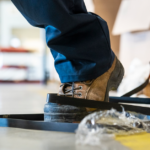Walk this way to workplace foot safety
Warm weather always means sandals, flip-flops and other casual footwear. While more comfortable in hotter weather, these styles may not always be the safest choice for the workplace. Feet are often overlooked when it comes to anticipating potential injury, but the right footwear can make all the difference between a debilitating incident or a near miss. Read on for more information on workplace foot safety.
Common foot injuries
There are many ways to help either prevent foot injuries or reduce their effect when they do occur. The injuries outlined below are among the most common but are not an exhaustive list. Familiarizing your workforce with this information, as well as recommended preventative measures, are a great way to take steps towards workplace foot safety.
Slips, trips and falls
These are both costly and common injuries in the workplace which can result in significant losses for employers. In fact, a recent article notes that an emphasis on preventing slips, trips and falls could eliminate 20 percent of all workplace injuries. While not always linked to foot injury, the common denominator in these types of incidents is that they usually begin at ground level, with the feet.
Related: Minimize workplace slips, trips and falls with these tips
Puncture, laceration and crushing injuries
Often a sharp object isn’t notice until it’s already been stepped on, resulting in either a puncture or laceration wound. Nails, glass or other hazards can easily slice through a thinly soled shoe. Injuries can also be sustained when objects are dropped onto an unprotected foot from a height. A falling object doesn’t have to be sharp to cause damage; nor does it have to be very heavy. Objects that are relatively easy for the average person to hold and carry, such as a hammer or a standard box of printer paper, can still result in injury if dropped onto a foot.
Foot fatigue
While not commonly recognized as an injury, foot fatigue is a serious issue that can greatly reduce an employee’s quality of life. While it may seem strange to classify foot fatigue as an injury, long term it can lead to permanent medical issues such as fallen arches, flat feet, arthritis and so on. The distracting and chronic pain stemming from foot fatigue can also lead to other injuries due to inattention.
Burns, weather and conditions
Other less common foot injuries that can still occur under the right circumstances or when wearing inadequate shoes are burns (electrical, chemical, thermal, etc.), sunburn, frostbite, blisters, athletes’ foot or other fungal conditions.
How to help ensure workplace foot safety
Prevent slips, trips, and falls with:
Proper fit. “Tripping over your own feet” is all but inevitable when wearing an ill-fitting shoe. Whether too big or too small, an improper fit impedes the natural flow of motion required for a steady, balanced stride.
Adequate traction. Form is often favored over function in shoes, and traction is a frequently overlooked design element. In some cases, a poorly designed shoe with no traction can cause a slip even on a surface where no true slip hazards are present.
Well-maintained walkways. Even the best shoes cannot prevent accidents when a walkway is impaired. Many flaws or hazards can be difficult to detect until the walker is already falling – and indoor small water spills and poor outdoor maintenance are classic examples. All walkways should be inspected regularly for damage or hazards. When discovered, these should be reported and flagged immediately. All repairs or housekeeping should be dealt with as swiftly as possible.
Prevent fatigue with:
Job rotation and sit-to-stand options. Even in a decent pair of shoes, standing on an unyielding floor can quickly cause foot discomfort. If possible, implement a job rotation schedule so that workers do not have to stand for their entire shift. Barring that, provide options that allow employees to sit or stand as they choose throughout their shifts or during designated times or tasks.
Regular breaks. If it is impossible or impracticable to implement job rotation or sit-to-stand solutions, ensuring that employees get adequate sitting breaks is a must. Consider going above and beyond whatever breaks are required by local laws and statutes to ensure that your employees can get through their workdays pain-free.
Anti-fatigue mats and insoles. Ideally all floors would be made from naturally feet-friendly material, such as wood, cork, carpeting or rubber, but feet will eventually experience fatigue on any surface. Installing anti-fatigue mats can be a useful measure; however, care must be taken to ensure they do not themselves become tripping hazards. An alternate solution is to implement an anti-fatigue insole program that allows workers to walk and stand on any surface for prolonged periods in greater comfort without the inherent hazards of stationary mats. Insoles should be replaced regularly if a program is implemented.
Prevent other injuries with:
Proper policy. Location has a lot to do in determining the official stance on protective footwear. It may be possible to have a more relaxed stance in an office environment, whereas more stricter measures would be necessary in settings such as kitchens or construction sites.
Protection. In locations where there is high likelihood of injury, require appropriately protective footwear. Bear in mind that a standard “closed-toe shoe” policy may not be sufficient, as there are many closed-toe styles that do not offer much in the way of protection. A tennis shoe, for example, may not necessarily be enough to stop an upturned nail from causing a puncture wound or provide any protection from crushing injuries. Thick rubber soles, steel toes and leather uppers are just some safety features that may be worth considering as requirements, depending on the situation.
Put your best foot forward
Every organization’s dress code should clearly outline what footwear is considered acceptable, provide the safety considerations that helped make the policy, and should be consistently enforced. Safety trainings on foot safety are also an excellent way to ensure employees take steps towards workplace foot safety. For more information, check out the following sources for this article. When it comes to foot safety, put your best foot forward!
Related: Workplace accidents and best practices for incident reporting
This article was originally published on Arrowhead’s corporate blog. It is used with permission and has been modified and updated to better fit the needs of our Preferred members.







